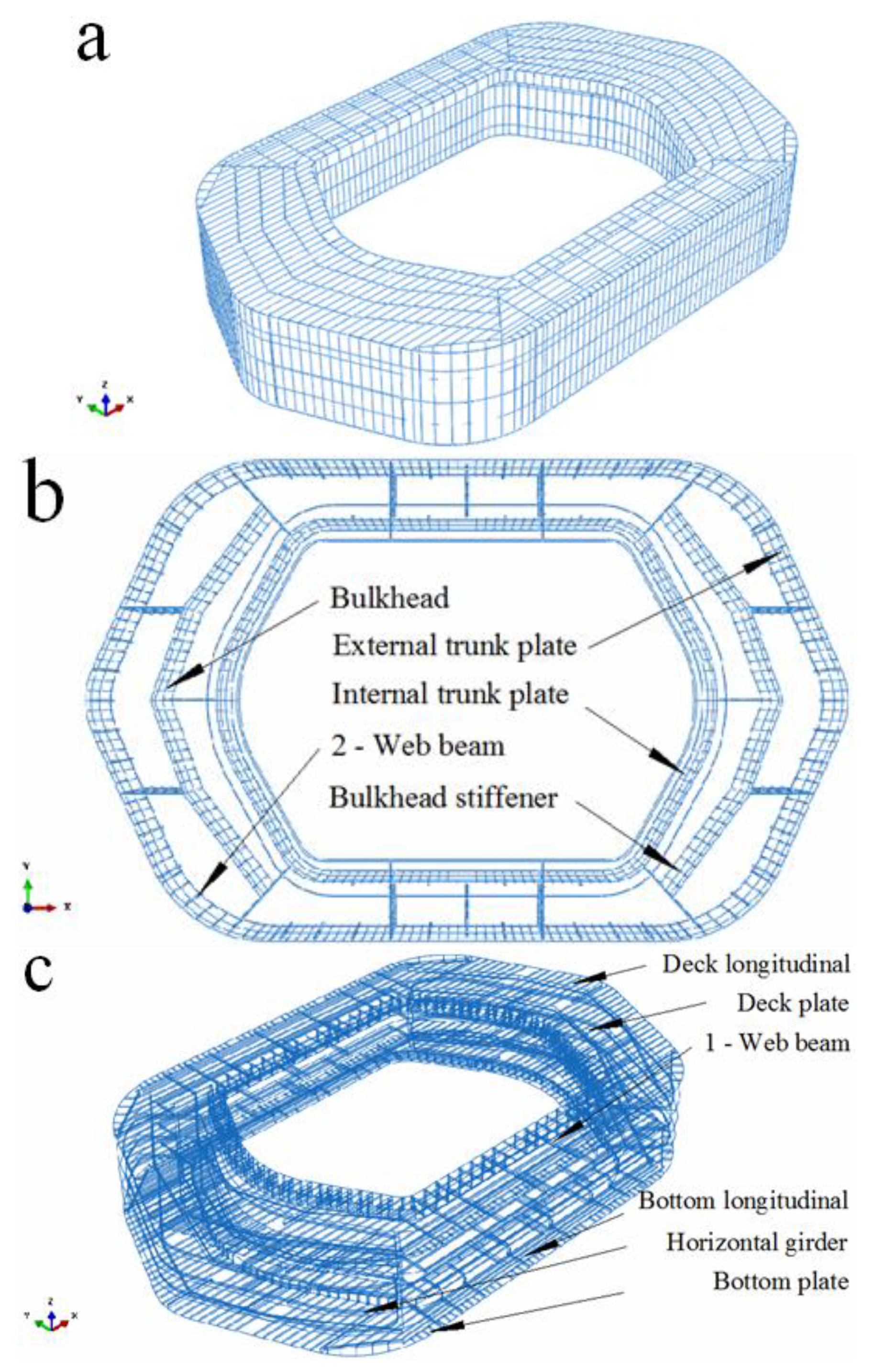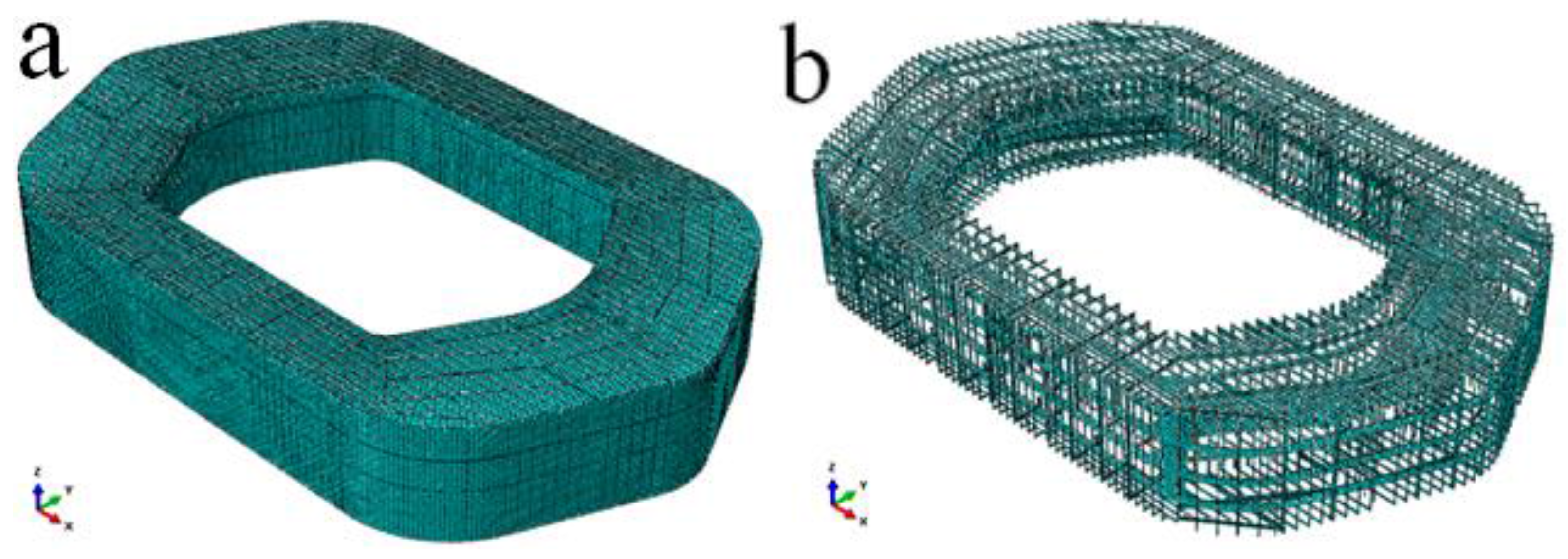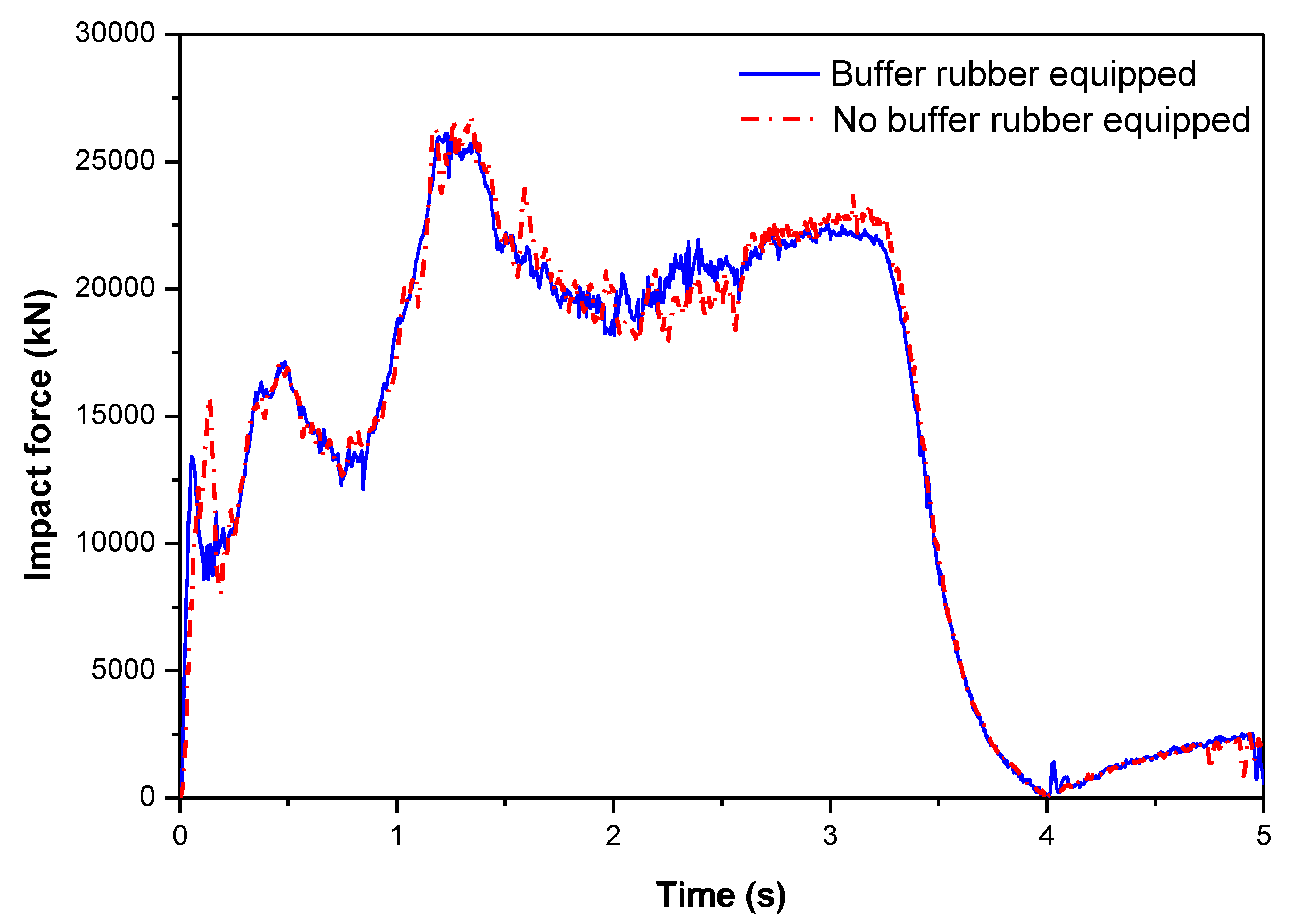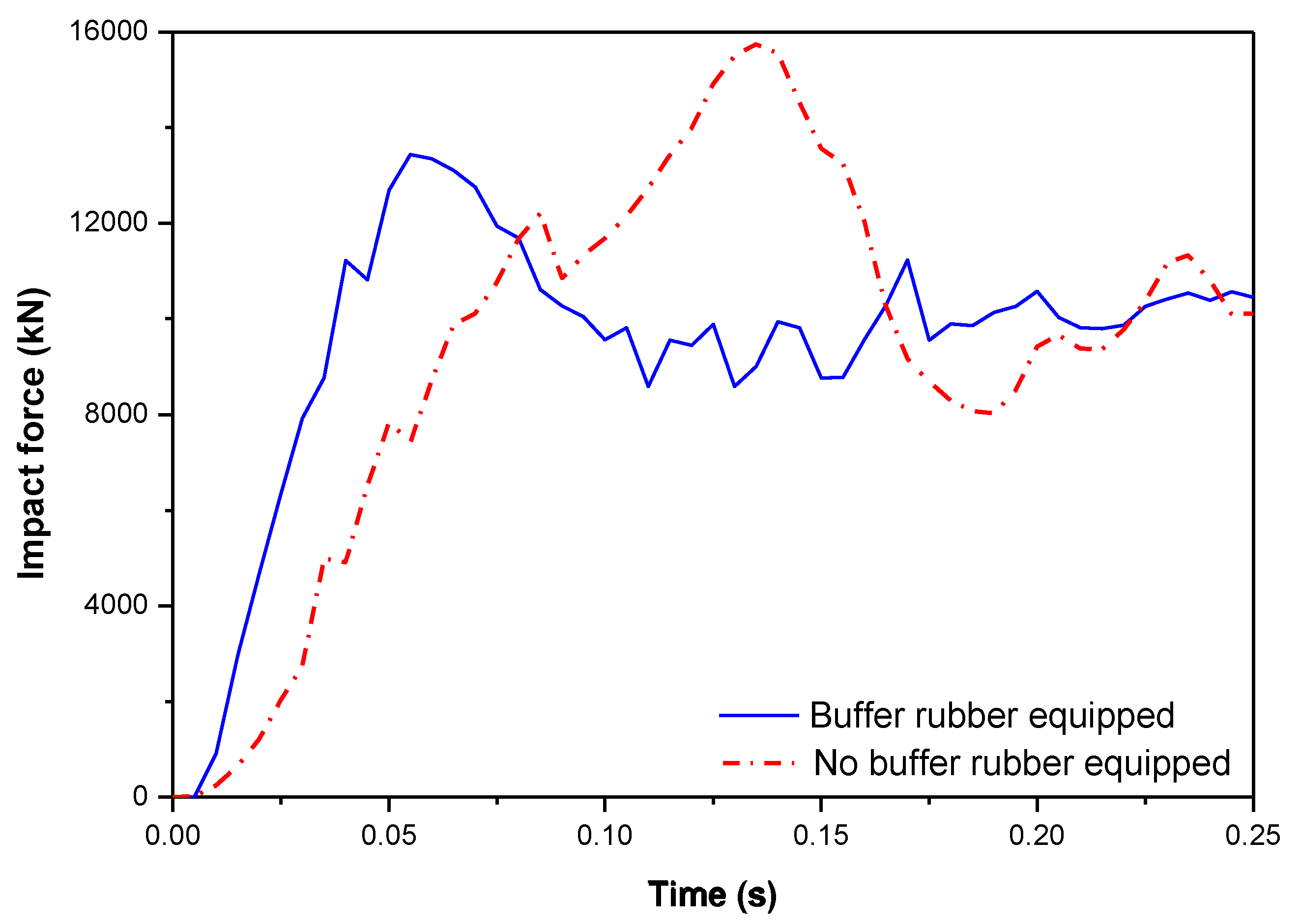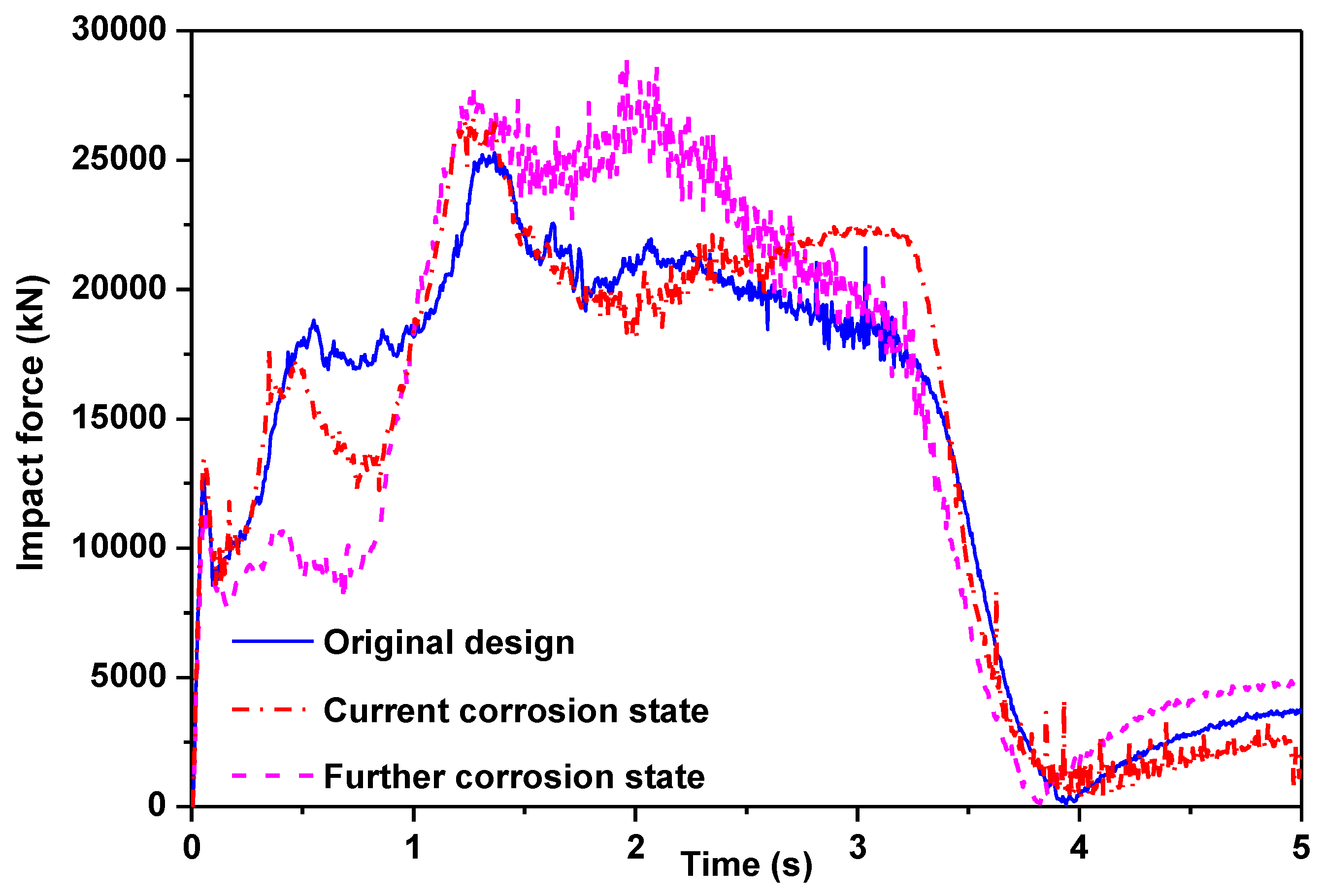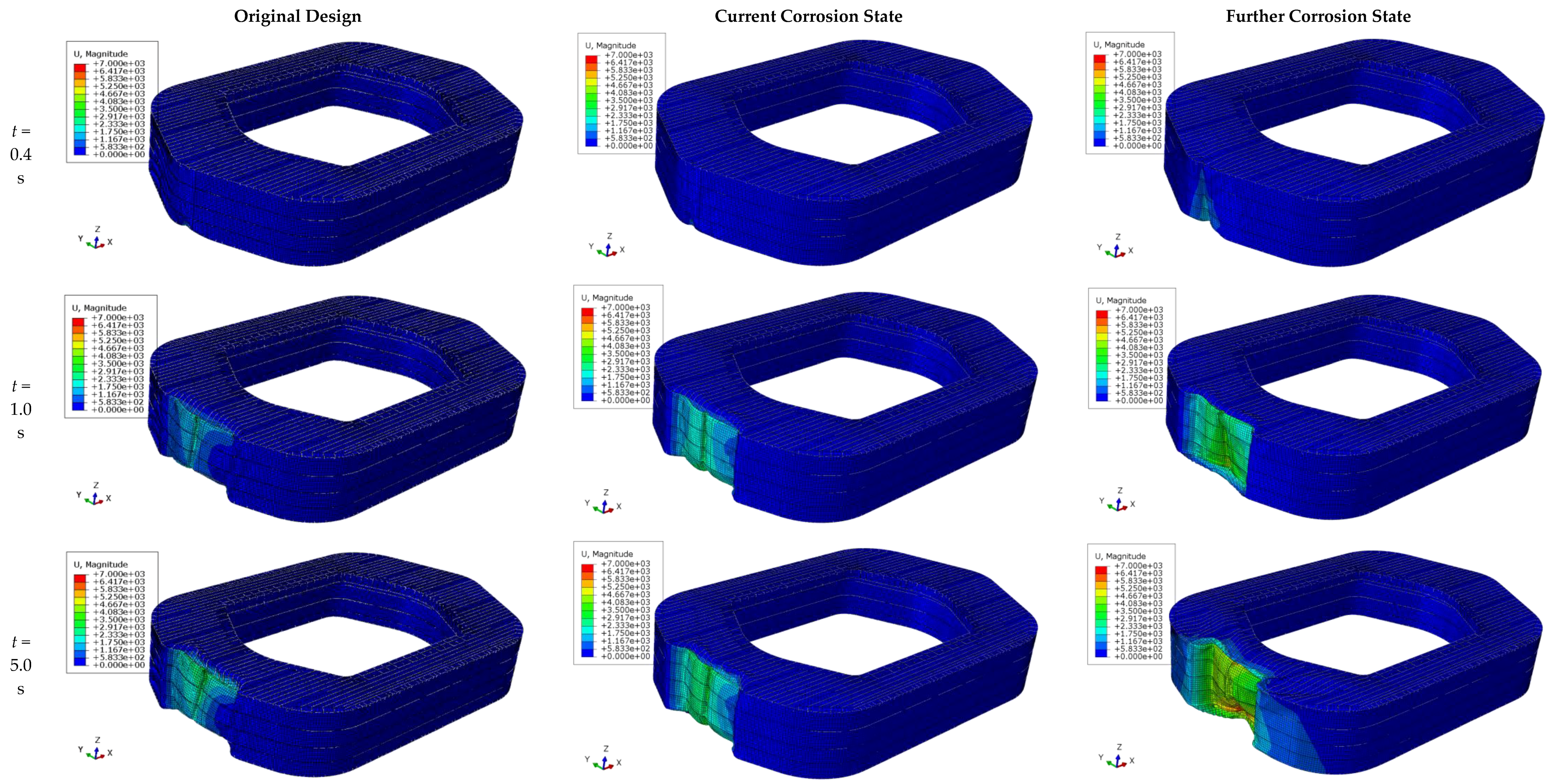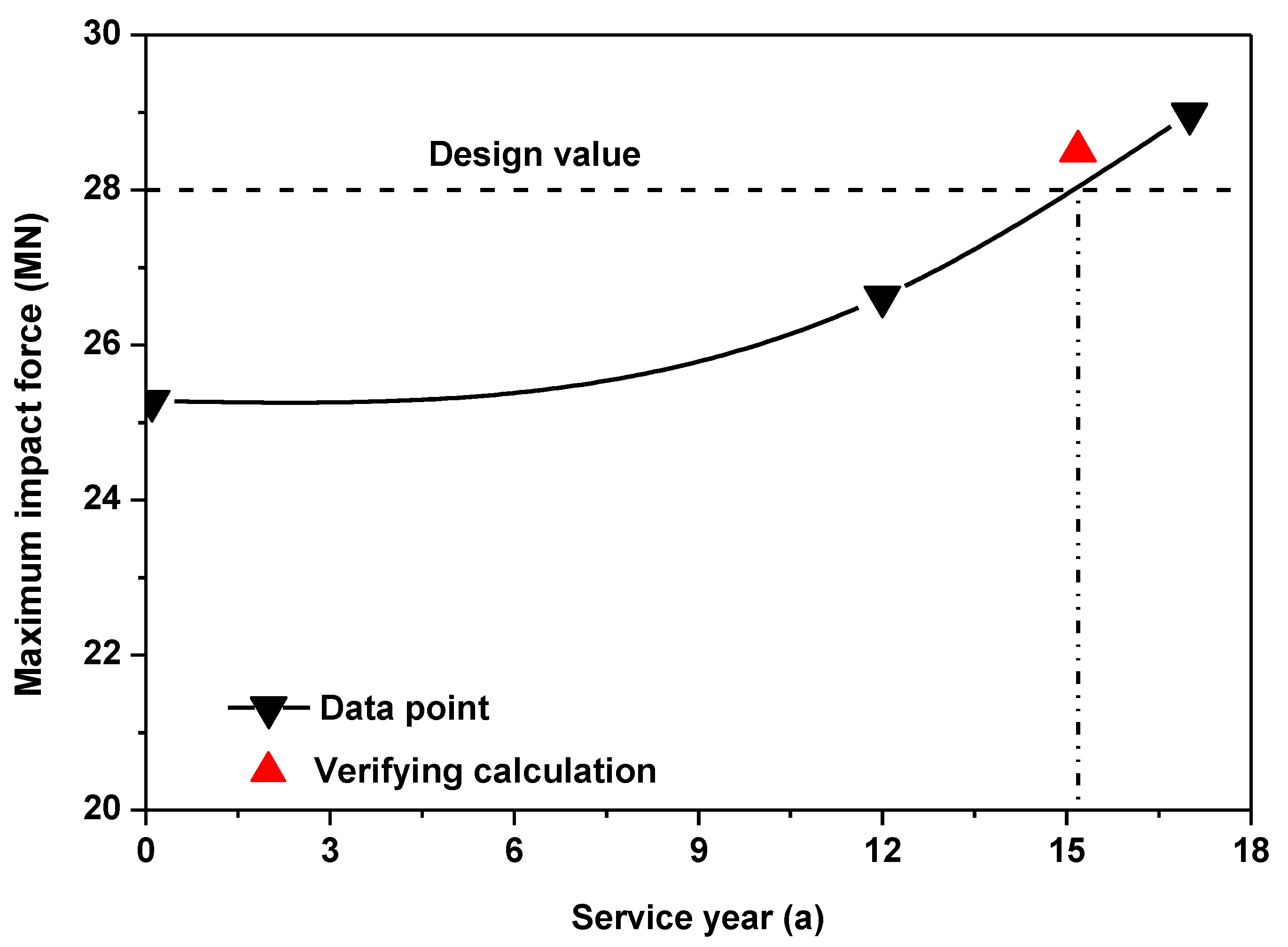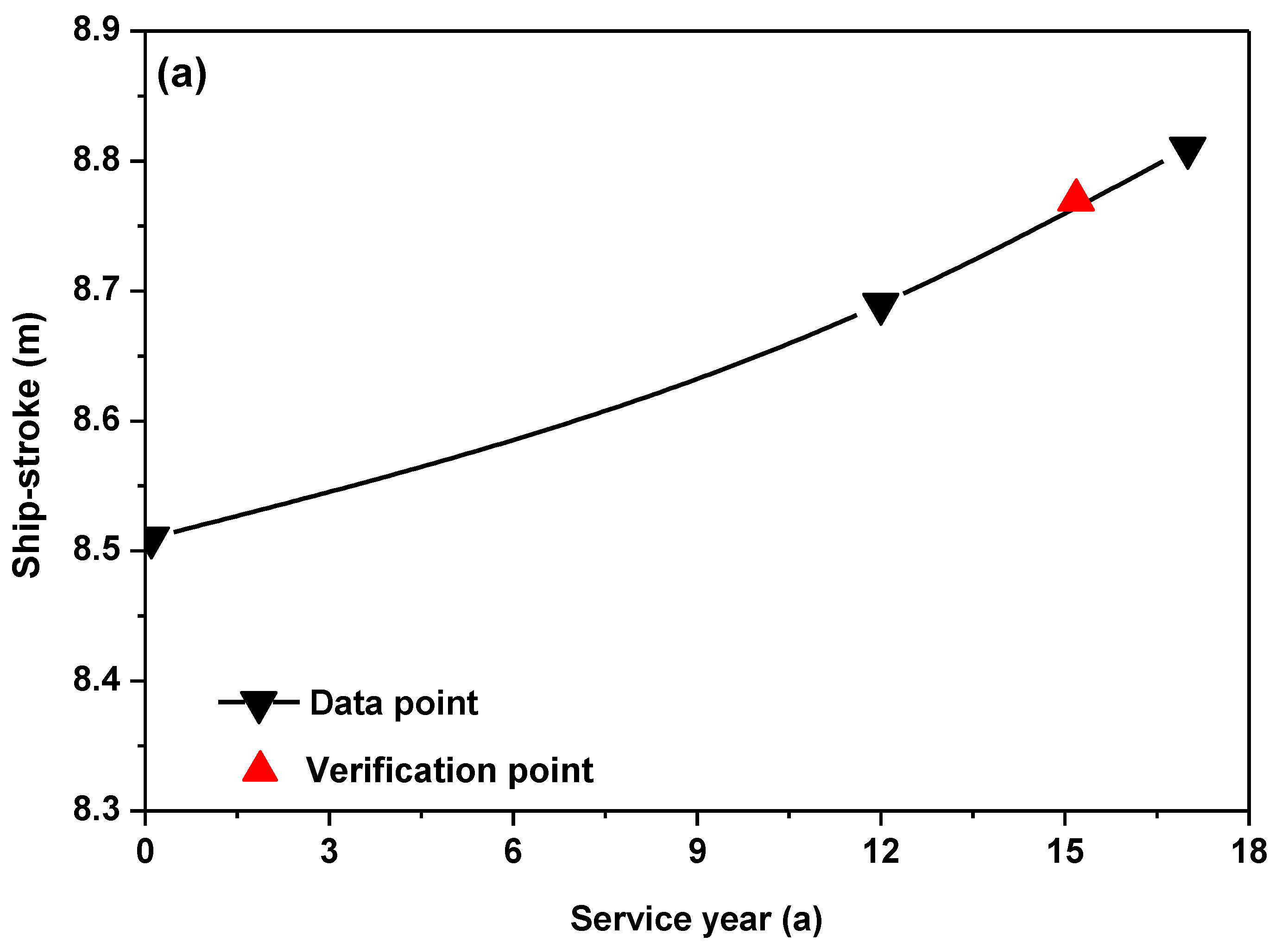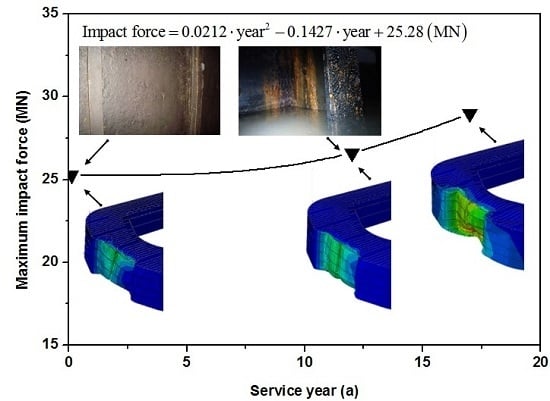1. Introduction
Steel is one of the most popular materials used in offshore and marine structures such as ships, ocean platforms, and submarine pipelines. The corrosion deterioration of steel can lead to heavy losses [
1]: in 2001 the annual worldwide cost of corrosion was around 3% of the world’s GDP [
2], and Khan [
3] summarized that 1034 incidents (44.7% of the total incidents) were caused by steel corrosion and the corresponding ‘mechanical failure’, including a series of serious incidents in 1988 and 1992 in the U.S. [
1,
4]. Many researchers have studied the mechanism of steel corrosion in marine and offshore environments. Jyoti et al. [
5] summarized previous research work and reported that temperature [
6], pH value [
7], salinity [
8], dissolved oxygen [
9], and water velocity [
10] were the main physical factors that affected the corrosion responses of steel. Besides the investigation of corrosion factors, other studies have focused on mechanism optimization. For example, Li et al. [
11] adjusted element contents within steel, and found that tin-containing steel had better corrosion resistance than steel itself.
The assessment of steel under a state of corrosion is another area of current research interest. Calabrese et al. [
12] studied the corrosion degradation effects of aluminum/steel clinched joints and pointed out that thicker aluminum foil could endow superior durability properties in large-scale applications. Chen et al. [
13] used finite element analysis (FEA) to investigate the failure processes of high-strength pipelines with single and multiple corrosions and produced an assessment procedure to predict the failure pressure of a pipeline with multiple corrosions. Jin et al. [
14] used FEA in considering the shear buckling behavior of a web panel with pits and through-thickness corrosion damage, and found that through-thickness corrosion damage significantly decreased the critical buckling load.
Bridge protective devices are among the many large-scale steel structures used in marine environments. They are energy-absorptive structures designed to withstand ship impact and depend on internal steel plastic damage [
15]. Many studies of ship–bridge collision responses [
16,
17] and device usage [
18,
19] have been reported. For example, Qiu et al. [
20] analyzed an original protective device scheme and proposed structural and material optimization for the protective device [
21,
22,
23].
Because of the many influencing factors, it is difficult to predict realistic corrosion responses of engineering structures based only on existing research conclusions and results, especially given the coupling effect of an antirust coat. Degradation of the anti-collision performance of protective devices influenced by corrosion has been insufficiently analyzed. In this study, a protective device that had worked for 12 years in a river estuary was selected as a research object, and its current corrosion response was detected on-site based on the corresponding standards [
24,
25]. Further corrosive response was predicted based on measurement data and the current state of the structure. The current degradation of the protective device’s anti-collision performance and the device’s further corrosion states were analyzed and predicted separately. An anti-collision performance prediction method for the protective device is proposed.
2. Model Description
Yamen Bridge is located in the Pearl River estuary, China. The estuary experiences severe engineering environments such as a high tidal range, high swell velocity, and large-tonnage ships shuttling back and forth over it. Thus, a protective device had been designed to protect the bridge piers from ship collisions. The main geometrical parameters of the studied device are listed in
Table 1. This protective device was a large-scale shell structure containing 14 watertight cabins and 4 non-watertight cabins assembled by deck plates, bottom plates, longitudinal bulkheads, transverse bulkheads, and trunk bulkheads. Each plate was enhanced by stiffeners with rib distance of 650 mm to ensure structural stability. Non-watertight cabins were used to adjust the protective device’s floating state when it was assembled around bridge piers. After assembly of the device, seawater could flow into the non-watertight cabins. This maintained the same water level within and outside the protective device and ensured that the protective device was unaffected by tidal levels. Seventy drum-type buffer rubbers were assembled on the inside bulkhead of the protective device, designed to absorb impact forces that the bridge pier received during ship collision.
Front collision is selected as the study case here, with the design value of the ultimate impact force being 28 MN. Cabins in the front direction would perform the main anti-collision functions.
Figure 1 shows a sketch of the protective device.
3. Corrosion Measurement and Prediction
The protective device had been manufactured and placed in the river estuary 12 years earlier and corrosion had certainly occurred within it. External views of the protective device were obtained first through a diver’s visual inspection; subsequently, each steel component’s residual thickness was measured by an ultrasonic thickness gauge. The whole structure of the protective device was examined to check whether pitting corrosion, bulking, weld crack, steel damage, or corrosion punching had occurred. Visual inspection and hammer testing were utilized in the tidal and spray zones, and diver inspection was utilized to detect the corrosion state of the immersed zone. Typical corrosion states of the protective device are shown in
Figure 2 and the detection results are listed in
Table 2. As shown in
Table 2, no apparent pitting corrosion, weld crack, or steel plate punching was observed, implying that no severe local damage had occurred.
Originally, undercoat and finishing had been painted on the protective device for anticorrosion purposes and a special undercoating containing Zn [
26] was used in the tidal zone, as steel in this zone oxidized more severe than in other zones [
5]. After years of immersion, however, rusting had occurred almost everywhere (see
Figure 2), the coating retained little anticorrosion effect, meanwhile, corrosion and structural loss had occurred in almost every part of the protective device. Components in the different zones (spray, tidal, and full immersion) were measured separately as they were situated in different environmental conditions (differences in temperature, dissolved oxygen, salinity, pH value, redox potential, etc.). As the protective device was a non-watertight structure, seawater perfused into the undersea cabins and thus seawater corrosion occurred on both sides of the steel components. In total, 500 points were selected to measure the residual thickness of the steel components and data were classified according to the design thickness of the steel component, as summarized in
Table 3. Comparisons of the different corrosion zones showed that the protective device experienced the most severe corrosion in the full immersion zone rather than in the tidal zone and its anticorrosion performance was best in the spray zone.
Pitting corrosion is regarded as one of the most hazardous forms of corrosion for traditional marine and offshore structures as it is a localized accelerated dissolution of metal that can weaken structural stiffness and lead to early catastrophic failure (oil leakage, product loss, environmental pollution, loss of life, for example) [
4]. Pitting corrosion does not greatly affect the function of a protective device, as pitting corrosion (even consequent piercing) merely causes local damage relative to the large-scale structure of the whole device and its influence on anti-collision performance is negligible [
27]. The design principle of the protective device is to absorb a large amount of the kinetic energy from the hull’s impact through plastic damage to the metal within itself. The amount of energy absorbed through plastic damage to the metal correlates with the mass loss and consequent thickness reduction of the metal. The average residual metal thicknesses of typical steel components of the protective device are listed in
Table 4. In the subsequent FEA, each steel plate or enhanced component is modeled with the average thickness detected by a thickness gauge as reported above.
According to the simulation results presented in the next section, the protective device at the current time could meet anti-collision requirements. As long as the protective device remained in active service around the bridge pier, everyday corrosion progressed. Further analysis to predict whether the protective device could retain its anti-collision performance after a long period of service is an important issue. The protective device was located in a marine environment and, when manufactured in a shipyard, it was designed with only 10 years’ service life. Most of its components were painted by hand-brushing using common marine coatings whose normal durability was 10 years. Thus, further corrosive responses need to be predicted if we want to study the subsequent corrosion response of the device and judge its ultimate service life. Steel components within the protective device were classified according to design thickness and the corrosion zone in which they were located, and then the further corrosive response of each classified group was predicted. The average residual thicknesses of typical components in their corrosion environment (5-year prediction) are listed in
Table 5.
5. Results and Discussion
5.1. Anti-Collision Effect of Buffer Rubber
As the protective device had been used and immersed in a corrosive environment for 12 years, the mechanical performance of the buffer rubber had significantly decreased. The current mechanical performance of the buffer rubber was not measured as it could not simply be represented by thickness reduction. Two models (cases 1 and 2) were built: one was equipped with buffer rubber and the other not, to represent typical/extreme cases, and the protective device’s anti-collision response is analyzed here.
The simulation results are listed in
Table 10 and the corresponding reaction force histories are shown in
Figure 4. The maximum value of the impact force received by the protective device is 26.79 MN in case 1, compared with 26.12 MN in case 2, an increase of 2.56%. The maximum ship stroke in case 1 is 8.69 m, compared with 8.71 m in case 2, a decrease of 0.23%. According to the discussion above, the protective device equipped with buffer rubber could decrease the maximum impact force and prolong the ship stroke, but the difference is not significant, as shown in
Figure 4. However, it is worth mentioning that buffer rubber can obviously decrease the impact force at the beginning of impact and allow the protective device to activate its function more quickly, as shown in
Figure 5. At the beginning stage of impact (within 0.15 s), the maximum impact force in case 1 is 15.75 MN (0.14 s), whereas in case 2 it is 13.43 MN (0.06 s), a decrease of 14.73%. Therefore, if the ship impact is too weak to damage the protective device’s steel components, the anti-collision effect of the buffer rubber is efficient and sufficient, but if the collision is too violent and must be resisted through structural damage within the protective device, the buffer rubber plays almost no role.
As the performance of the protective device was demonstrated by the ultimate collision state and the ship collision cases discussed here were all violent, the buffer rubber was insignificant with regard to the impact response in the ultimate collision state. In the following cases, the protective device models are all equipped with buffer rubber and the corrosive state of the steel components is the only parameter investigated.
5.2. Corrosion Effects on the Protective Device
Models of the protective device in the original design, with current corrosion, and with predicted further corrosion were built separately. Simulation results are listed in
Table 11. The lowest maximum impact force experienced by the bridge piers occurs in case 3 (25.28 MN) and the highest maximum impact force increases as corrosion continues, with values in cases 4 and 5 of 26.62 MN and 28.98 MN respectively, increases of 5.3% and 14.6% respectively from the original design state. It is worth noting that the maximum impact force in case 5 exceeds the ultimate design value (28 MN), which means that the protective device cannot meet design requirements in this predicted further corrosion state. Reaction force histories are shown in
Figure 6, in which the shape of the reaction force history with the original design is somewhat rectangular, revealing that the range of variation of the impact force is greater with the original design than in the corrosion states. The ship collision is the most severe in the predicted further corrosion state: not only is the peak value of the reaction force (28.98 MN) higher, but also the variation of the reaction force and the corresponding acceleration velocity is more turbulent, with higher acceleration velocity than in the other two cases.
The buffering effect of the protective device tended to be less when the plate thickness decreased under the action of corrosion, and the extent of corresponding structural deformation was more severe once the ship collision occurred. Deformation responses of the protective device during impact are shown in
Figure 7. In the beginning stage of impact, the protective device in the further corrosion state deforms most easily. During the entire impact process, the extent of deformation and damage of the protective device is the greatest in the further corrosion state.
5.3. Prediction of Performance Degradation
The protective device was a large-scale shell structure assembled with different steel components located in different corrosion zones. As the corrosion characteristics in the spray zone, the tidal zone, and the full immersion zone differed, and the size of steel components could also influence the corrosion process, it was difficult to accurately quantify the overall corrosion response of the protective device. Moreover, ship collision is a complex impact process that involves problems of material nonlinearity (metal plasticity and rubber hyperelasticity), geometric nonlinearity (large deformation), and boundary nonlinearity (boundary variation). All these factors increase the difficulty in predicting the anti-collision performance of the protective device after further corrosion. Based on the simulation results discussed here, a polynomial equation is proposed to judge the variation trend of the maximum impact force. Then a new case is calculated to judge the validity of the equation through comparison with the design value. The anti-collision performance of the protective devices is further discussed from the perspectives of ship stroke and residual mass of the device.
The maximum impact forces under different corrosion states were calculated and are listed in
Table 11. According to these data plotted in
Figure 8, a prediction equation (Equation (1)) was derived by a polynomial fitting method to show the evolution trend:
With substitution of the design value (28 MN) into Equation (1), the calculated service life was 15.18 years. A new FE model was built up considering the corrosion effect after 15.18 years. The upper triangle (with red color) in
Figure 8 represents the maximum reaction force calculated with the new FE model, and it is evident that it matches the evolution trend well. The evolution trend of anti-collision performance follows a quadratic nonlinear relationship and is unlike the corrosion effect of the steel component, which is determined by a unique spot in the marine environment and is an approximately linear relationship [
5]. To further investigate the corrosion response in the protective device, other impact factors were analyzed and verified by this simulation case, from which the corresponding data points and fitted curves are shown in
Figure 9. Each verification point falls exactly on the respective fitting curve, which means that, under the corrosion effect, both the quadratic curves plotted are valid and they fit the variation trend of each factor well. Therefore, the variation trend of device’s anti-collision response follows a quadratic nonlinear relationship under the corrosion effect, which is unlike the linearly changing corrosion effect, because too many influencing factors are involved. However, prediction of this variation trend depends merely on three calculation values referring to different corrosion durations, respectively.
6. Conclusions
When the Yamen Bridge protective device located in the Pearl River estuary had been in active service for 12 years, on-site measurement was utilized to detect its current corrosion response. Further, the evolution of its corrosion was predicted based on measurement data and corresponding theories. The anti-collision performance of the protective device was analyzed taking into account the corrosion effect, and a performance prediction method was proposed. If a ship’s impact is too weak to damage the protective device’s steel components, the anti-collision effect of the buffer rubber is considerable, but if the ship’s impact is so great that it must be resisted through structural damage within the protective device, the buffer rubber plays almost no role. The anti-collision response of the protective device under the corrosion effect followed a quadratic nonlinear variation trend that was accurately predicted by a quadratic curve determined by three calculation values with reference to different corrosion durations.
